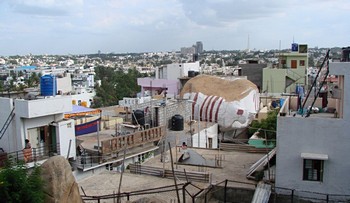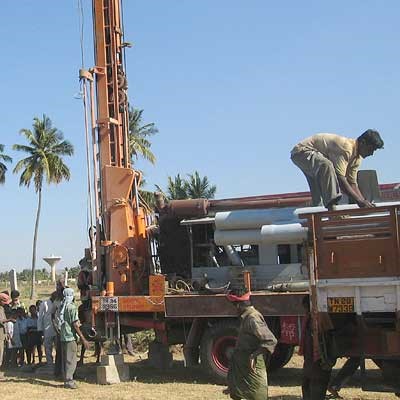The first statistically sound city-level survey shows the many means that Bengaluru residents rely on to get water, and sets the stage for evidence-based planning.
Public taps and handpumps are an important source of water for poor households, but cannot be solely relied on for all of families’ water needs. Photo: Deepak Malghan.
Just as households use portfolios – a range of investments – to manage their finances, Indian households use porfolios to manage household water supply. In both cases, diversification is a key tool in balancing risks and returns.
Households cope with water insecurity imposed by inadequate public water supply by investing in a diversity of water supply and demand management options. In this article, we share the first results from the country’s first statistically sound city-level survey, which is part of the Urban Metabolism Project. This information will be key for proper water planning.
If you live in Bengaluru (Bangalore city), chances are you get water from the Bangalore Water Supply and Sewerage Board, but only on alternating days, and then only for a few hours. Consumers in the southern and western parts of the city, closest to the inlet from the Kaveri River, tend to get better water access than those in the north of the city.
Simply put, the supply isn’t keeping up with Bengaluru’s explosive growth. Bengaluru had 8.5 million residents in 2011 – up nearly 3 million from a decade earlier and 7 million from 1971. Peripheral areas with particularly poor water service have seen some of the fastest growth, with rates in some outlying wards topping 300% from 2001-2011. Unofficial reports put Bengaluru’s current population at more than 10 million.
The BWSSB estimated that the 950 million liters of water per day it provided in 2011 was 450 mld less than what Bengaluru needed, and this shortfall would rise to 650 mld by 2021 and 1,450 mld by 2031, as the city’s population continues to surge.

This forces residents to rely upon a mix of water delivery systems, and devise systems to store water when it’s available. The Central Groundwater Board estimated in 2011 that 40% of Bengaluru’s population depended on wells, including water people draw directly and water people buy from private suppliers that tap wells.
This groundwater pumping is a problem for a couple of big reasons. First, a 2012 study estimated that wells draw nearly four times the amount that would be sustainable, based on the rate of recharge. In addition, the Department of Mines and Geology found in 2003 than more than half of groundwater samples from 735 locations in Bengaluru did not meet drinking water standards, putting health at risk. Studies in various Indian cities have shown that intermittent supply in water pipes, using motors to suck water from mains and storing water all pose risks to water quality.
Poor residents, particularly on the fringes of the city, are more likely to rely on informal water distribution. They have to walk to and from water sources, wait in line, pay more than they would for municipal water, and then risk their health on potentially unsafe water (while also taking time to boil the water for increased safety).
Understanding the complexity of water supply and demand balance at the level of Indian households is essential for at least four reasons:
For the Bangalore Domestic Water Survey conducted in 2013, 75 polling booth boundaries were chosen, distributed over five regions. Within each polling booth boundary, representatives from 350 to 650 households answered basic questions regarding water acquisition and storage. Then, 20 households from each booth were randomly chosen for an extensive interview.
The survey found that nearly 85% of households use public water supply. However, public water supply is the sole water source only for 42% of Bengaluru’s households. Respondents chose 18 of the 23 ways of getting water that we asked about.
The dominant option was Bangalore Water Supply and Sewerage Board water piped into the yard, with almost 62% of Bangalore’s households using this. Between 18% and 20% of households use at least one of the following means: BWSSB piped water directly into the dwelling, shared private borewells, private tankers, bottled water and BWSSB public standposts. Much less common are sources like open wells, tankers run by public agencies, water carts and cycles, and hospital-supplied water.
Of the 18 water supply options, as many as 12 depend entirely on groundwater. There are three options where surface and groundwater is mixed, i.e both surface and groundwater is sourced: BWSSB tankers, hospital supply and neighbours’ utilities. BWSSB pipes supply only surface water.

Based on our results, it’s possible to look at this from a household perspective:
Further analysis of survey results will consider how much water people get from different sources, how much people pay for water, how many private wells there are in Bengaluru, and how information from the survey relates to what in developed countries are standard economic method to evaluate price controls on water demand.
A longer and more detailed version of this post first appeared on the Bangalore Urban Metabolism Project website.
Design and development by Soapbox.
